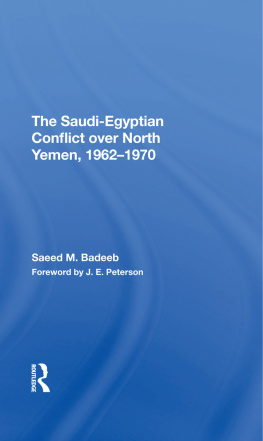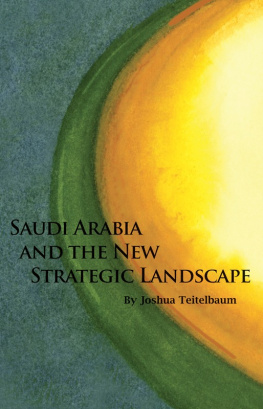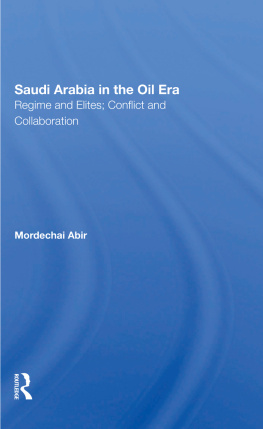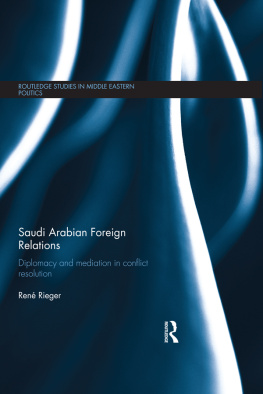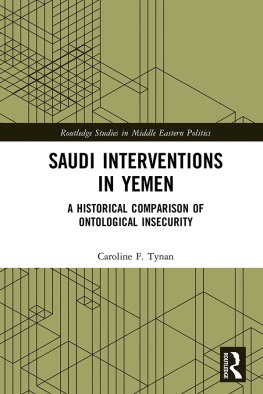The Saudi-Egyptian Conflict over North Yemen, 1962-1970
About the Book and Author
The 1962 coup d'tat in North Yemen initiated one of the most debilitating Middle East conflicts ever, the eight-year civil war in North Yemen. This conflict in an obscure corner of the Arab world eventually assumed global importance, attracting the attention of the superpowers and the United Nations.
This book focuses on the Yemeni civil war's impact at the regional level, where it provoked enmity between two influential Arab states, Saudi Arabia and Egypt. Dr. Badeeb argues that for Egypt, the war constituted a means of intensifying and confirming its role as the leader of the revolutionary camp in the Arab world. For Saudi Arabia, however, it presented a direct challenge to the security and stability of the kingdom. Dr. Badeeb provides a valuable elucidation of Saudi Arabia's concern over Yemen as a potential source of political and strategic upheaval. This lately unappreciated aspect of the regional security picture is in part a legacy of the Saudi-Egyptian conflict of the 1960s and is one of the central elements of current Saudi security policy.
Saeed M. Badeeb was born in Jeddah, Saudi Arabia. After earning a B.A. in 1971 and an M.A. in 1975 from the University of Karachi, Pakistan, in 1983 he received a Master of Philosophy degree and in 1985 a Ph.D. from The George Washington University. His fields of specialization were International Relations and Comparative Government and Politics. From 1972 to 1975 Badeeb served as First Secretary of the Saudi Government Advisory Council (Royal Court). From 1980 to 1984 he served as a political adviser in the embassy of Saudi Arabia in Washington, D.C. He is currently a deputy minister without portfolio in the government of Saudi Arabia.
The Saudi-Egyptian Conflict over North Yemen, 19621970
Saeed M. Badeeb
Foreword by J. E. Peterson
First published 1986 by Westview Press
Published 2019 by Routledge
52 Vanderbilt Avenue, New York, NY 10017
2 Park Square, Milton Park, Abingdon, Oxon OX14 4RN
Routledge is an imprint of the Taylor & Francis Group, an informa business
Copyright 1986 by the American-Arab Affairs Council
All rights reserved. No part of this book may be reprinted or reproduced or utilised in any form or by any electronic, mechanical, or other means, now known or hereafter invented, including photocopying and recording, or in any information storage or retrieval system, without permission in writing from the publishers.
Notice:
Product or corporate names may be trademarks or registered trademarks, and are used only for identification and explanation without intent to infringe.
Library of Congress Cataloging-in-Publication Data
Badeeb, Saeed M.
The Saudi-Egyptian conflict over North Yemen,
19621970.
Includes bibliographies and index.
1. YemenHistory1962 . 2. EgyptForeign
relationsSaudi Arabia. 3. Saudi ArabiaForeign
relationsEgypt. I. Title.
DS247.Y48B22 1986 953'.32 86-19115
ISBN 13: 978-0-367-29568-4 (hbk)
To the memory of my father (God rest his soul in peace)
Twenty years ago, the young Yemen Arab Republic was emerging from the wreckage of a long, debilitating civil war. The 1960s were the heyday of the Arab Cold War, that titanic struggle between the opposing forces of progressives and conservatives, between radicals and reactionaries. It was principally a bloodless clash of ideological rhetoric between the new, military-dominated republics and the older, more traditional monarchies for the soul of the Arab world.
But the rugged mountains and terraced valleys of far-off Yemen became the Arab world's battlefields by proxy, and the fighting there was as much between Egypt and Saudi Arabia as it was between Yemeni republicans and royalists. The war in Yemen raged on for five hard years until the June 1967 Arab-Israeli war forced Egypt's disengagement. But the process of "national reconciliation" in Yemen was not completed until 1970, and only then could the first foundations of a modern, effective state be established.
One important consequence of the civil war and the subsequent national reconciliation was the creation of an enduring alliance between Saudi Arabia and the YAR. The geographical proximity of these two countries, their conservative outlooks, similar societies and common threat perceptions, the contribution made by many thousands of Yemeni workers to the development of Saudi Arabia and the kingdom's considerable financial assistance to its much poorer neighbor, have all played a role in forging what Dr. Saeed Badeeb has termed "the inevitable partnership."
Dr. Badeeb's study is a valuable contribution for several reasons. First, he has expanded our knowledge about the wider ramifications of the Yemeni civil war, particularly the causes and extent of Egyptian and Saudi involvement. At the same time, the transcript of Dr. Badeeb's interview with the former Imam, Muhammad al-Badr, constitutes a fascinating and rare look at the thinking of one of the principal participants in the events of the 1960s.
Second, Dr. Badeeb presents one of the most detailed accounts of the historical, political, economic and security ties between Saudi Arabia and Yemen in print. While the key importance of the Saudi-Yemeni relationship is widely recognized, its component elements, scope and limits rarely have been analyzed to the extent found in this study.
Third, most studies of Saudi Arabia and Yemen have been written by westerners and therefore inevitably reflect a Western viewpoint. As a Saudi citizen and government official, as well as a recipient of a Ph.D. degree from The George Washington University, Dr. Badeeb is uniquely qualified to offer this scholarly and readable analysis of the evolution and present status of one of Saudi Arabia's key foreign-policy concerns.
This welcome and useful book is bound to leave the reader with the hope that it will be the first of many comparable studies by Saudi and other Gulf Arab authors.
J. E. Peterson
Author of Yemen: The Search for a Modern State
Washington, DC
July 1986
There are many who contributed to the completion of this work and who deserve my sincere thanks and gratitude. Among those is H.M. Imam Muhammad al-Badr, who was kind enough to see me twice, answering my questions and writing me a valuable historical document. Others, such as Mr. Mahmoud Riad, and a number of Saudi, Yemeni and American present and ex-officials, who played important roles during the Yemeni crisis, were very helpful and responded thoughtfully to my questions and inquiries. At their request, I have omitted any specific reference to them. I also wish to express my appreciation to the professors from George Washington University who guided my dissertation and to Frederick W. Axelgard of Georgetown University's Center for Strategic and International Studies; Anne Joyce, Director of Publications of the American-Arab Affairs Council; and Joyce Bouvier, the manuscript typist, for their efforts.
During the research for this study I was fortunate to have access to government and private archives and materials which were indispensable for the completion of the work. The individuals who helped to make these materials available to me performed an invaluable service. To all these, and many others who were kind enough to share their expertise and knowledge with me, I would like to say thank you, thank you very much.


